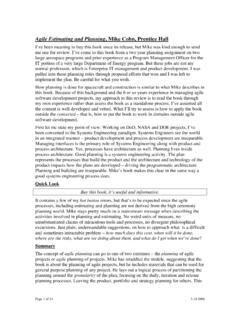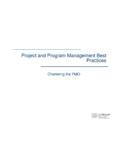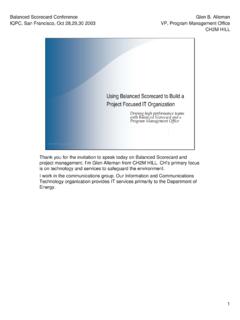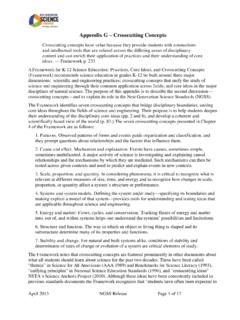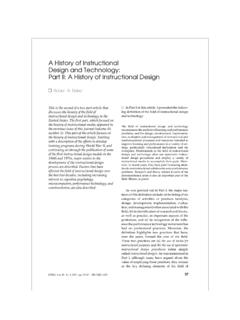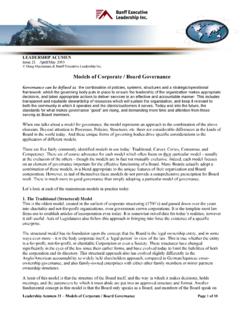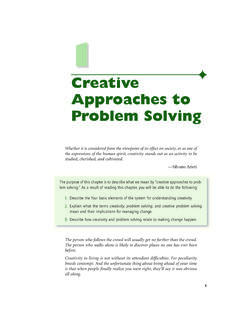Transcription of An Introduction to IMP/IMS - Niwot Ridge
1 IMP/IMS 2003 the US Government revised its acquisition policies with a procurement strategy focused on process improvement and acquisition reform implemented by performance-based Introduction to IMP/IMSGlen B AllemanNiwot, ColoradoPlanning projects usually starts with tasks and milestones. The planner gathers this information from the participants customers, engineers, subject matter experts. This information is usually arranged in the form of activities and milestones. PMBOK defines project time management in this manner. The activities are then sequenced according to the projects needs and mandatory usual critical path methods are then used to determine the estimated completion date, risk areas of the project and other statistical planning s missing from the concept of this task-oriented schedule is the realization that the plan is not the same as done. A description of done is usually not part of the plan in an explicit manner. Rather is usually found inside of a specification.
2 It s there in implicit form after all the tasks are the US Department of Defense version of PMBOK Section 6 (Project Time Management) this task-oriented approach is replaced by IMP/IMS . Why was this done? The DoD version as well as the US Air Force IMP/IMS guides don t explicitly state the reason for replacing the traditional planning approach with 2/54 Program Management is a Full Contact SportWe ve all had experiences in much the same as the carton charters shown here. Things are going along well, even the numbers all look good. Then the surprise happens. Sometimes out of the blue, sometimes with a clear vision of the train wreck happening before our does the happen? If there was a simple answer to this question all the efforts of program management, tools and processes would not be needed. The answer is we don t really know why projects fail in any detail that would allow us to avoid failure with certainty. There are many authors, professional organizations, and government agencies who profess to have a solution.
3 But in the end its simply not possible to state assuredly how to avoid for improvement certainly exist. Obvious failure modes can be identified and avoided. Postmortems can easily identify the gaps that occurred with or without the knowledge of the project managers, customers, and 3/54 Booz Allen Hamilton s 16 Program Management Processes Program EnablersProgram Process CapabilitiesBusiness Enablers15: PM Process Management15: PM Process Management16: PM Development and Succession16: PM Development and SuccessionProgram Management Framework11: Organization/IPD11: Organization/IPD12: Customer Partnership12: Customer Partnership13: Program Review Process13: Program Review Process14: Configuration/ Data Management14: Configuration/ Data Management2: Program Planning2: Program Planning3: Performance Management3: Performance Management4: Sub-Contract Management4: Sub-Contract Management5: Follow-On Business Development5: Follow-On Business Development9: Financial Management9: Financial Management10: Risk Management10: Risk Management7: Requirements Management7: Requirements Management8: Schedule Management8.
4 Schedule Management6: Earned Value Management6: Earned Value Management1: Program Management Involvement in Proposal 1: Program Management Involvement in Proposal Booz Allen Hamilton defined 16 processes for program management. These all appear obvious on the surface as any good idea challenge is to put these practices into practice on real programs with real people and real Program Process Capabilities (1 10) are the core of the IMP/IMS outcomes. Planning, performance management, subcontract relations, cost, and earned value are critical operational activities for the success of any these processes to be effective, there has to be a clearly defined statement of work, a cooperative customer, a skilled and qualified team, proper funding, and most importantly a feasible solution to the customer s even with all these pre-conditions, projects get in s missing? The IMP/IMS approach would say what s missing is a way to assess the incremental progress of the program in a way that can be measured in unambiguous terms.
5 By defining done in terms of events, accomplishments, and criteria, progress of the program can be 4/54 Why IMP/IMS ?zProposal Preparation Emphasize real integrated product development Provide flexibility in performing detailed planningzContract Award At post-award conference, provides a basis of mutual understandingzProgram Execution Identify and assess program progress based on done rather then passage of time or effort expended Assess program maturity through pre-defined accomplishmentsThere are no simple answers for the question why use IMP/IMS ? As well there doesn t seem to be much in the way of documentation for the deployment of IMP/IMS . The fact is though that the world is littered with failed projects. Even after decades of professional development, bodies of knowledge, endless seminars and training processes and even Presidential are an equal number of successful projects. The parametersof project success or project failure are elusive. But one thing is clear, without a concise definition of done , no process will 5/54 What is the Integrated Master Plan?
6 ZThe IMP is an event based plan, rather than a task basedplan A hierarchy of program events defines the program flow Each event is supported by specific accomplishments Each accomplishment has specific criteria to be satisfiedzThe IMP tracks the step-by-step completion of the required accomplishments for each eventzThe IMP demonstrates the satisfactory completion criteria for each accomplishmentThe Integrated Master Plan is a collection of milestones ( IMP/IMS calls them events) that form the process architecture of the program. This means the sequence of events that will result in a deliverable product or products or services is relatively straight forward in many cases. List the tasks to be done, arrange them in the proper sequence, execute this plan. Several problems appear immediately: The description of done is many times missing for the intermediate activities. As products or services are delivered the maturity of the program is as critical as quality, functionality, and other program attributes.
7 This maturity is an insurance policy against problems encountered in the program. Program partners, integration activities, subcontractors all have unknown or possibly unknowable impacts on the program Exposing done to and from the IPTs builds a shared version of done IMP/IMS 6/54 What is the Integrated Master Plan?zThe IMP is NOTbased on calendar dates, therefore it is not schedule oriented Each event is completed when its supporting accomplishments are completed This completion is evidenced by the satisfaction of the criteriasupporting each of the accomplishmentszMany of the events in an IMP are fixed by customer milestones PDR, CDR, Production deliveryzIntermediate events are defined by the supplier Integration and test, Software releases, TRRThe critical attribute of the IMP is its focus on events. This is in comparison to effort or task focused planning. The event focus asks and answers the question what does done look like? Rather than what work has been done.
8 Certainly work must be done to complete a task. But focusing on the work hides the more important metric of are we meeting our commitments? Meeting commitments is critical but the criteria for judging if the commitments are being met comes first. This is where Significant Accomplishments and their Accomplishment Criteria become important. It is important to meet commitments, but recognizing when the commitment has been met is even more 7/54 What is the Integrated Master Schedule?zThe IMS flows directly from the IMP, and is linked to: Work Breakdown Structure Statement of Work Earned Value Management SystemzThe IMS is used to manage the day-to-day execution of the program Tracking program technical and schedule status Managing and mitigating program risk Incrementally assessing the maturity of the programThe term Integrated Master Schedule sounds obvious on the surface. A project schedule that is integrated. But what does integrated really mean? Integrated at what level?
9 Integrated with what components?The IMS integrates the Events with Tasks. The work efforts that produce accomplishments, assess these accomplishments through criteria and complete the Events are the basis of the IMP/IMSIMP/IMS 8/54 The Importance of the IMP/IMSzThe IMP/IMS is the single most important document to a program s success It clearly demonstrates the providers understanding of the program requirements and the soundness of the approach a represented by the planzThe program uses the IMP/IMS to provide: Up Front Planning and commitment from all participants A balanced design discipline with risk mitigation activities Integrated requirements including production and support Management with an incremental verification for informed programdecisionsThis may sound like hype, but without a clear and concise description of what is to be delivered, tied to the plan, with measurement criteria the program has no way of knowing how it is performing other than the passage of timeThe emphasis on maturity is seen in product development programs.
10 In one off programs there is no cyclic process on which to base maturity of the product. But in these one off programs, progress of the program toward the goal can be seen a 9/54 Misconceptions of IMP/IMSzToo big and burdensome for our small dollar programzWe ll spend gobs of B&P money maintaining a thick documentzIt s a management tool not a technical toolzI want IPTs without the burden of IPD or IMP/IMSThe first impulse to IMP/IMS is this is great on large weapons systems procurements. SBIRS for example. But for our small to moderate program it s a lot of work for not much second misconception is IMP/IMS is part of the proposal and procurement process, used to assess contractors on their ability to manage the program. This is true. BUT if this assessment shows competence in the proposal phase, why not continue the processes during the execution phase. Test as you Fly, should be augmented with Execute as you Propose. IMP/IMS 10/54 Product vs Functional FocusEngineeringTestMfgSuppliersContract ingLegalFinancial MgtLogisticsDesignSpace SegmentSE| Satellite| PayloadGround SegmentSatellite Cntl| Data FusionI&T SegmentPM| SE| I&TEngineeringTestMfgSuppliersContractin g LegalFinancial MgtLogisticsDesignSpace SegmentSE| Satellite| PayloadGround SegmentSatellite Cntl| Data FusionI&T SegmentPM| SE| I&TProduct-OrientedFunctional-OrientedTh ere is much discussion in the project management literature about the differences between product processes and project processes.

